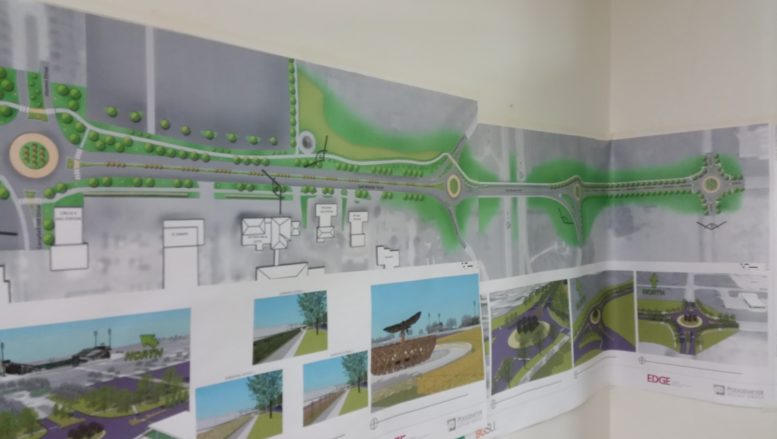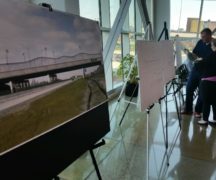By JAN LARSON McLAUGHLIN
BG Independent News
Bowling Green officials may soon seek another go-round at more roundabout funding.
On Monday, Bowling Green City Council will hear the first readings of resolutions for two more roundabouts on East Wooster Street.
The city is already working with the Ohio Department of Transportation on roundabouts at the Interstate 75 interchanges on East Wooster Street. The resolutions before council on Monday involve the intersections of East Wooster at Campbell Hill and Dunbridge roads.
If approved, ODOT would pay 80 percent of the roundabout costs, with Bowling Green paying the remaining 20 percent. That means for the Campbell Hill rotary, estimated to cost $1,525,000, Bowling Green would pay $310,000 plus $153,000 for project preparation. For the Dunbridge Road rotary, estimated to cost $935,000, Bowling Green’s share would be $190,000, plus $95,000 for project preparation.
Bowling Green is already working with ODOT to put two roundabouts at I-75 and East Wooster Street in 2018. The work will include pedestrian access along the bridge deck and aesthetic improvements for those entering the community.
The Toledo Metropolitan Area Council of Governments is seeking transportation projects that might qualify for the Congestion Mitigation and Air Quality program. Roundabouts often qualify since they allow traffic to continue moving at a steady pace unlike regular intersections that require motorists to stop and go.
In addition to creating less air pollution, city officials are interested in the roundabouts because the East Wooster Street Concept Plan identified these locations for intersection improvements, including a “new look” for the corridor. The plan calls for a calmer and more aesthetically pleasing entrance to the city with a landscaped median as part of that concept.
Since the East Wooster corridor is the “front door” to the community, the plan suggested increasing trees, calming traffic and adding improvements for pedestrians.
Another benefit, according to city officials, is that fewer left hand turns into and out of businesses will be required because of the roundabouts. That is expected to decrease the number of serious vehicle crashes in the corridor.
The funding decisions will not be made until December. If Bowling Green is awarded funds, the money may not be available until 2022 or later.
Applications for the funds are due June 2, so City Council will be asked to give the resolutions their first readings on Monday, then their second and third readings on May 15.
Surveys submitted last year by Bowling Green residents, about the proposed East Wooster corridor work, showed a great deal of suspicion about the roundabouts. But city officials believe that once citizens realize the safety benefits, and experience the ease maneuvering around them, that most motorists will be sold.
Though roundabouts are common intersection features in many parts of the nation, Wood County has been slow warming up to the idea. Bowling Green Public Works Director Brian Craft, who has done his research on the circular intersections, believes the roundabouts would be good for the city for a variety of reasons.
First, they are safer. “They are designed to intentionally make you slow down,” Craft said last year. Head-on and high-speed right angle collisions are virtually eliminated with roundabouts.
Second, they can save money by not requiring stop signal installation and maintenance.
And third, they can help the city meet its goal of making the east entrance to the city more aesthetically pleasing. The center areas of roundabouts are often landscaped. “That’s the front door to our city and it’s the front door to the university,” Craft said. “This would dress up the corridor a little bit.”
The city administration has posted the following information on roundabouts on the city website in an effort to answer common questions about the rotaries.
- Roundabouts are designed to be safer and more efficient than a traditional intersection. The design of the roundabout creates a low speed (20-30 mph) environment and prevents high angle crashes such as “T-bone” crashes. Low angle, low speed crashes tend to be less severe than higher angle, high speed crashes.
- Roundabouts are more efficient. Vehicles are able to move more quickly through the intersection because of the “yield at entry” – drivers only have to watch for traffic from the left, and if there is an adequate gap available, they can enter the intersection without stopping. Once in the roundabout, drivers have the right-of-way, so they will not have to stop or yield to exit. If the driver does need to yield at entry to traffic inside the roundabout, their delays are brief and typically less than the time they would have been delayed at a traffic signal.
- The design makes room for semi-trucks. Incorporated into the design of roundabouts is something called a “truck apron.” The truck apron is the area between the central island and the roadway that is mountable by larger vehicles but not used by passenger vehicles. Typically this area is concrete versus the roadway which is asphalt.
- According to the U.S. Department of Transportation Federal Highway Administration, roundabouts reduce the types of crashes where people are seriously hurt or killed by 78-82 percent when compared to conventional stop-controlled and signalized intersections.





